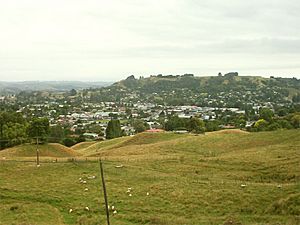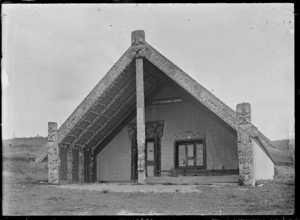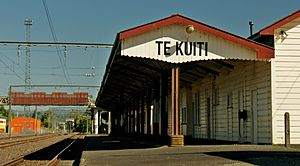Te Kūiti facts for kids
Quick facts for kids
Te Kūiti
|
|
|---|---|
|
Minor urban area
|
|

Te Kūiti viewed from the south-west as SH3 climbs out of the town.
|
|
| Country | New Zealand |
| Region | Waikato region |
| District | Waitomo District |
| Ward | Te Kuiti Ward |
| Electorates |
|
| Area | |
| • Total | 8.41 km2 (3.25 sq mi) |
| Population
(June 2023)
|
|
| • Total | 4,680 |
| • Density | 556.5/km2 (1,441.3/sq mi) |
| Postcode(s) |
3910
|
Te Kūiti is a town in New Zealand, located in the northern part of the North Island. It's in a special area called the King Country. This town is easy to find, sitting where two main roads (State Highways 3 and 30) meet. It's also on the main railway line, about 80 kilometers south of Hamilton.
Te Kūiti is famous for sheep shearing! It calls itself the "sheep shearing capital of the world." Every year, it hosts the New Zealand National Shearing Championships. The town is about 80 kilometers south of Hamilton and 19 kilometers south-east of Waitomo. The area around Te Kūiti is known as the King Country. This name is even used for the local rugby team, which is based in Te Kūiti.
Contents
Discover Te Kūiti's Past
The name "Te Kūiti" comes from the Māori language. Its full original name was "Te Kūititanga." This means "the valley," "the squeezing in," or "the narrowing." It describes how the land looks.
Many special Māori meeting places, called marae, are found in and around Te Kūiti. These marae are connected to the Ngāti Maniapoto hapū (sub-tribes).
- Te Kumi Marae and its meeting house, Te Korapatu, belong to Ngāti Peehi and Rōrā.
- Mōtītī Marae and its meeting house, Ko te Hungaiti or Hapainga, belong to Ngāti Kinohaku, Ngāti Putaitemuri, and Ngāti Tauhunu.
- Te Piruru Papakainga Marae and its meeting house, Te Pukenui o Taonui, belong to Ngāti Rōrā.
- Tāne Hopuwai Marae and its meeting house, Tāne Hopuwai, belong to Ngāti Apakura.
- Te Tokanganui a Noho Marae and its meeting house are connected to Ngāti Rōrā. This meeting house was built in 1873 for Te Kooti and his followers. It was one of the biggest meeting houses ever built at that time.
- Tomotuki Marae and its meeting house, Parekatini, belong to Apakura, Parekaitini, and Ngāti Rōrā.
- Te Waipatoto Marae, with its meeting houses Waipatoto and Waipatoto Tuarua, belong to Ngāti Kinohaku.
Exploring Te Kūiti's Nature
The area around Te Kūiti has a lot of limestone. Over time, water has carved out amazing Waitomo Caves to the northwest of the town. These caves are one of New Zealand's most popular places for tourists to visit.
Te Kūiti itself sits in a valley. This valley also has many rich limestone deposits. The Manga-o-Kewa Stream flows through the valley. This stream then joins the Waipā River. The land around Te Kūiti is mostly farmland and places where limestone is dug up. The landscape is very hilly, which is typical for the North King Country region.
What's the Weather Like?
Te Kūiti has a climate that is wet in the winter. It tends to be dry during the late summer. On average, the town gets about 1,450 millimeters of rain each year.
| Climate data for Te Kuiti (1991–2020) | |||||||||||||
|---|---|---|---|---|---|---|---|---|---|---|---|---|---|
| Month | Jan | Feb | Mar | Apr | May | Jun | Jul | Aug | Sep | Oct | Nov | Dec | Year |
| Mean daily maximum °C (°F) | 24.4 (75.9) |
24.9 (76.8) |
23.3 (73.9) |
20.1 (68.2) |
16.9 (62.4) |
14.3 (57.7) |
13.6 (56.5) |
14.7 (58.5) |
16.5 (61.7) |
18.0 (64.4) |
20.1 (68.2) |
22.4 (72.3) |
19.1 (66.4) |
| Daily mean °C (°F) | 18.3 (64.9) |
18.9 (66.0) |
17.0 (62.6) |
14.3 (57.7) |
11.6 (52.9) |
9.4 (48.9) |
8.6 (47.5) |
9.6 (49.3) |
11.4 (52.5) |
13.0 (55.4) |
14.5 (58.1) |
17.0 (62.6) |
13.6 (56.5) |
| Mean daily minimum °C (°F) | 12.3 (54.1) |
12.8 (55.0) |
10.7 (51.3) |
8.5 (47.3) |
6.3 (43.3) |
4.4 (39.9) |
3.6 (38.5) |
4.5 (40.1) |
6.4 (43.5) |
8.0 (46.4) |
9.0 (48.2) |
11.5 (52.7) |
8.2 (46.7) |
| Average rainfall mm (inches) | 83.8 (3.30) |
82.7 (3.26) |
75.8 (2.98) |
107.9 (4.25) |
140.9 (5.55) |
144.1 (5.67) |
174.1 (6.85) |
138.8 (5.46) |
137.5 (5.41) |
133.6 (5.26) |
115.0 (4.53) |
129.3 (5.09) |
1,463.5 (57.61) |
| Mean monthly sunshine hours | 221.6 | 180.7 | 191.4 | 147.5 | 120.6 | 102.5 | 109.6 | 127.8 | 134.2 | 164.6 | 184.8 | 185.8 | 1,871.1 |
| Source: NIWA | |||||||||||||
People of Te Kūiti
Te Kūiti covers about 8.41 square kilometers. In 2018, its estimated population was 4,680. This means there were about 556.5 people living in each square kilometer.
| Historical population | ||
|---|---|---|
| Year | Pop. | ±% p.a. |
| 2001 | 4,374 | — |
| 2006 | 4,494 | +0.54% |
| 2013 | 4,257 | −0.77% |
| 2018 | 4,572 | +1.44% |
At the 2018 New Zealand census, Te Kūiti had 4,572 people. This was an increase of 315 people since 2013. There were 1,611 households in the town. The population included 2,241 males and 2,331 females. About 22.8% of the people were under 15 years old.
The people of Te Kūiti come from different backgrounds. About 51.7% identified as European/Pākehā. A large part, 55.2%, identified as Māori. There were also people from Pacific peoples (5.6%) and Asian backgrounds (5.7%). Some people identified with more than one ethnicity.
About 11.4% of the people in Te Kūiti were born outside New Zealand. This is lower than the national average of 27.1%. When asked about religion, 50.2% said they had no religion. About 32.7% were Christian. Some people followed Māori religious beliefs (4.4%). Other religions like Hindu, Muslim, and Buddhist were also present.
Fun Things to Do in Te Kūiti
As the "Shearing Capital of the World," Te Kūiti has the world's largest statue of a shearer. It stands seven meters tall! On April 1, 2006, the town hosted the biggest sheep show ever. More than 2,000 sheep were part of it.
The beautifully carved Te Tokanganui-a-Noho meeting house is a very important place. It was given to the local Māori people (Ngāti Maniapoto) by Te Kooti. He was a famous Māori leader from the 1800s. The chiefs of Maniapoto protected Te Kooti from the government. While under their protection, he carved this special house. It is one of the most famous and important spiritual houses from the late 1800s in the North Island. This house is key to Te Kūiti's history. It is also seen as the center of the Rohe Pōtae, or "King Country." In 1881, this area was opened up to new settlers.
You can also visit the Tatsuno Japanese Garden. It is located at the southern end of the main street. The Mangaokewa reserve is about 5 kilometers south of Te Kūiti. It's a popular spot for many activities. People go there for rock climbing, hiking, picnics, swimming, and fishing for trout.
The Te Kuiti railway station is a historic building. A project started in 2014 to make it new again. This project aims to create spaces for arts and crafts, an education center, and youth projects. It will also have historical displays and a meeting room. The Rail Heritage Trust says the station is "the finest remaining example of a standard class B station."
Sports in Te Kūiti
Te Kūiti is home to the Waitete Rugby Football Club. It is also where the King Country Rugby Union is based. Both teams play at Rugby Park. The legendary Colin Meads, a famous rugby player, played his entire career for both Waitete and King Country.
The town also has a soccer club called Te Kuiti Albion Football Club. They play in the Deacon Shield tournament. Their home games are at Centennial Park, which has a small clubroom. The team's colors are yellow and black striped shirts with black shorts.
Learning in Te Kūiti
Te Kūiti has six schools for students.
- Te Kūiti Primary School is a state primary school.
- Pukenui School is another state primary school.
- Centennial Park School is also a state primary school.
- St Joseph's Catholic School is a Catholic primary school that is part of the state system.
- Te Kūiti High School is the state secondary school.
- Te Wharekura o Maniapoto is a state Māori immersion school. This means lessons are taught mainly in the Māori language.
All these schools welcome both boys and girls.
Famous People from Te Kūiti
Many notable people have connections to Te Kūiti.
- Ross Beever is a geneticist and expert on fungi.
- Rodney Bell is a contemporary dancer.
- Jim Bolger, a former Prime Minister of New Zealand, used to represent the local King Country area.
- Kevin Boroevich is a former All Black rugby player.
- Walter Broadfoot (1881–1965) was a cabinet minister. He was also the deputy mayor and then mayor of Te Kūiti for many years.
- Kim Chambers is a marathon swimmer.
- David Fagan is a World Champion Sheep Shearer.
- Kerri-Jo Te Huia is also a champion sheep shearer.
- Murray Kidd was a rugby union coach for the Irish national team.
- Tony Martin is a comedian and author who lives in Australia.
- Sir Colin Meads, a legendary All Black rugby player, lived in Te Kūiti. A statue of him was put up in the town center in 2017. He was there for the event, even though he was battling cancer.
- Colin Meads's brother, Stanley Meads, another rugby player, also lived in Te Kūiti.
- Les Munro was the last surviving pilot from the famous Dambusters air raid. He was mayor of Te Kūiti for some years, and a street is named after him.
- Ruth Park is a well-known author.
- Kevin Proctor is a Rugby League player for the Gold Coast Titans.
- Diggeress Te Kanawa was a master weaver (tohunga raranga) of Ngati Maniapoto and Ngati Kinohaku descent.
- Rob Waddell is an Olympic gold-medalist rower.





